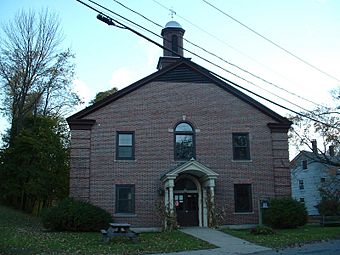Conway Center Historic District facts for kids
Quick facts for kids |
|
|
Conway Center Historic District
|
|

Conway Town Hall
|
|
| Location | Conway, Massachusetts |
|---|---|
| Area | 24 acres (9.7 ha) |
| Built | 1830 |
| Architectural style | Federal, Greek Revival |
| NRHP reference No. | 99001043 |
| Added to NRHP | September 10, 1999 |
The Conway Center Historic District is a special area in Conway, Massachusetts. It's like a time capsule showing how the town grew between the 1830s and 1930s. This district is mostly along Main Street, which is part of Massachusetts Route 116. It also includes parts of Elm Street and Academy Hill Road. This historic area was added to the National Register of Historic Places in 1999 because of its important history.
Contents
Discovering Conway Center's Past
The town of Conway was first settled in the 1760s. It officially became a town in 1767. The first town meetinghouse and early inns were near the South River. This area was along the main road that went from east to west.
How Conway Center Grew
In the 1800s, the town started to see more business. Factories began to open, especially in Burkeville, a short distance west of the center. In 1832, the main road was moved a bit south. This is when the Conway Center we see today really started to take shape.
Later in the 1800s, the town's textile mills faced challenges. This was partly because the area didn't have a railroad. Even when a streetcar rail was finally added, it wasn't enough to save the mills.
What You Can See Today
Many buildings in Conway Center are old houses. Most of them were built in the 1800s using wood frames. You can also spot some Colonial Revival style buildings from the early 1900s.
About 40% of the buildings were built during a busy time in the 1840s and 1850s. These often show the Greek Revival style of architecture.
Famous Buildings and Landmarks
Some important buildings in the district include:
- The Masonic Hall: Built in 1895-1896, it has a unique Queen Anne style.
- The Field Memorial Library: Built in 1901, it shows the Classical Revival style.
The district also includes the bridge that carries Main Street over the river. This concrete bridge was built in 1925. At the western end of the district, where several roads meet, there's a traffic island. On this island, you'll find a water fountain. It was put there in 1905 by the Woman's Christian Temperance Union.



